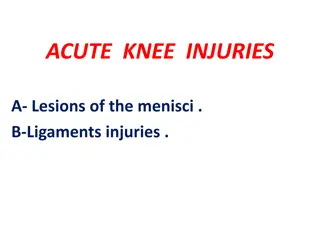A Model-Based Approach to Injuries in Professional Ice Hockey
This study explores the correlation between injuries and team performance in ice hockey, aiming to create models that predict man games lost for players and teams. Factors such as player events on the ice and historical injury data are considered to understand the impact of injuries on team success. Data collected from 2009-10 to 2016-17 seasons provides valuable insights for developing injury prediction models in professional ice hockey.
Download Presentation

Please find below an Image/Link to download the presentation.
The content on the website is provided AS IS for your information and personal use only. It may not be sold, licensed, or shared on other websites without obtaining consent from the author.If you encounter any issues during the download, it is possible that the publisher has removed the file from their server.
You are allowed to download the files provided on this website for personal or commercial use, subject to the condition that they are used lawfully. All files are the property of their respective owners.
The content on the website is provided AS IS for your information and personal use only. It may not be sold, licensed, or shared on other websites without obtaining consent from the author.
E N D
Presentation Transcript
A MODEL BASED APPROACH TO INJURIES Jeremy F. Sylvain1, Dr. Michael E. Schuckers2, & Dr. Nathan Currier3
BACKGROUND: In 2016-17, the correlation between percent cap hit of injured players per game and points per game is -0.31 (nhlinjuryviz.blogspot.com) In 2016-17 3 most injured teams VAN, WPG, and BUF, all failed to make the playoffs* The 3 least injured teams WSH, CGY, and STL all made the playoffs and WSH and STL both moved on to the second round* *mangameslost.com
INTRODUCTION: Injured teams struggle to be successful Injuries to players often impacts the decisions that managers and coaches have to make Important to try and capture injuries in a model for teams to understand what their needs are going forward
PRIOR WORK: 2 Model approach* - Probability Model - Severity Model Collision statistics rooted in how many games played* - Seasonal production Injuries occurring in prior seasons were not taken into consideration* *(Sylvain & Schuckers, 2017)
GOALS: Create a model to capture injuries that occur during a regular season Base these models on factors that occur in game play - Events while the player is on the ice Use these models to create predict man games lost for individual players as well as teams
DATA: Data From mangameslost.com and hockey-reference.com Data collected from 2009-10 season to 2016-2017 season to allow us to collect stable estimates Variable INJ GP TOI-GM HGT BPT HTT AGE AGE2 inD Definition Games a player lost due to injury Games played by a player Average time on ice played per game in all situations Hits a player gives divided by time on ice Shots a player blocks divided by time on ice Hits a player taken divided by time on ice Age of player as if January 1st, of each season in years Age of a player squared in years Indicator determining the position of the player
DATA: Further for each season model, we use the prior 3 season s INJ in the model To be included in the study you must have had a combination of 20 INJ and GP, as we feel at that point a player has seen a rigorous amount of a season Below is an example of a player: Alexander Edler: Variable GP INJ TOI.GM HTT BPT AGE AGE2 inD 2016 2015 2014 Edler 68.0 0 14.00 19.70 6.70 5.07 30.72 943.75 1.00 30.00 8.00 16.00
DATA: All game situations (ES, PP, PK) aggerated Forwards and defensemen (goalies not included) 2012-13 2013-14 2014-15 2015-16 2016-17 Number of Players 602 694 685 676 687 Proportion of Players with INJ 1 55.1% 69.0% 67.7% 68.3% 65.4% Proportion of Players with INJ 10 22.1% 34.3% 32.0% 33.4% 31.9% Mean games missed 5.7 9.2 9.1 9.4 8.4 Median games missed 1 5 4 4 3
INJURY PRONE: Injury prone is a term that is thrown around frequently Never really been evaluated (to our knowledge) Evaluate players susceptibility to injuries across multiple years
METHOD: Break seasons into three year cohorts Identify players who were injured more than 10 games in each of the three years within the cohort of interest Calculate the average seasonal injury rate by averaging the seasonal injury rate Compare the expected number of players missing more than 10 games to the actual number of players
INJURY PRONE: Statistically significant difference between the expected number of players who missed more than 10 games in each cohort season and the actual numbers Gives reason to use prior seasons INJ going forward in our models. Cohort Players Playing in All Seasons 461 429 426 416 470 446 379 Avg Injury Rate 0.311 0.290 0.299 0.295 0.331 0.325 0.328 Expected INJ 10 13.900 11.240 11.387 10.680 17.000 15.310 4.440 Actual INJ 10 P-Value 10.11.12 11.12.13 12.13.14 13.14.15 14.15.16 15.16.17 14.15.16.17 15 18 18 18 36 31 14 0.324 0.027 0.031 0.017 0.000 0.000 0.000
ANALYSIS: HTT and BPT are collision factors that occur in a game HIT and BLK are divided by TOI.GM to account for production while a player is on the ice not on a game by game basis To account for susceptibility due to aging, we use quadratic model for aging. To account for prior injuries and to model injury prone players we include the prior 3 season injuries
MODELS: Different from prior studies we used one model instead of a probability and severity models Model uses a quasiPoisson (overdispersion) distribution Model: INJt ~ TOI.GM + HTT + BPT + AGE + AGE2 + inD + INJt-1+ INJt-2 +INJt-3 *Where t represents the year of interest
RESULTS: - Represents a significant coefficient that is negative + Represents a significant coefficient that is positive Season TOI.GM HTT BPT AGE AGE2 inD INJt-1 INJt-2 INJt-3 2016-17 - - + + + + 2015-16 - - + + 2014-15 - - + + 2013-14 - - + - + + 2012-13 - - +
RESULTS: Position makes a difference Getting hit and blocking shots are significant but not as expected - Would expect the coefficients to be positive Prior seasons make a difference TOI. GM doesn t effect the severity of an injury.
APPLICATION: Fit the 2015-16 model to the 2016-17 data Ran this simulation for 1,000 repetitions to create distribution of team INJ Compared the predicted INJ for each team to the actual INJ for each team from last season. Red line in following graphs represents the Total number of injuries for the 2016-17 season for each team
ISSUES: Questions arise for modeling injuries for rookies (they have not played in three seasons) Concussion protocol does potentially factors into this (2012) Does special teams make a difference LTIR players who clearly are not coming back to the league
GOING FORWARD: When the injury occurred? Where the injury occurred? Does the off season training have an impact? Is there a difference between short term and long term injuries? PREDICTING INJURIES IS HARD.
THANK YOU j.sylvain01@gmail.com @ImaSlyGuy01























